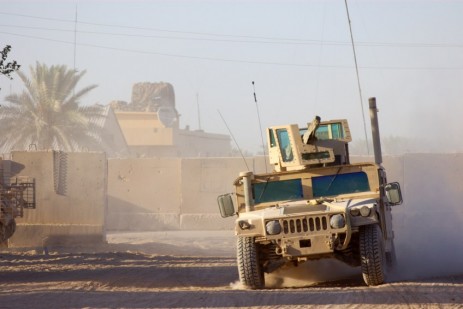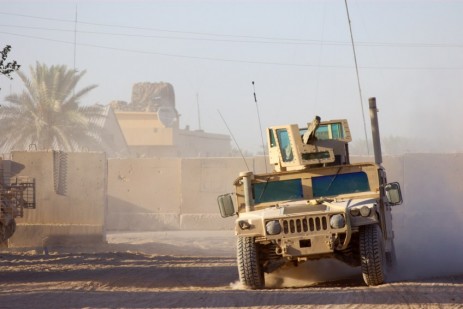 Don’t ask what kind of mileage it gets.In the summer of 2006, Marine Corps Major General Richard Zilmer sent the Pentagon an unusual “Priority 1” request for emergency battlefield supplies. Stationed at a temporary base in Fallujah, Zilmer was commanding a force of 30,000 troops responsible for protecting Al Anbar, the vast territory in western Iraq bordering Saudi Arabia, Jordan, and Syria. Heavily armed insurgents were hammering the region, and Al Qaeda was quickly gathering recruits. Zilmer’s beleaguered soldiers were running low on fuel for the diesel generators powering their barracks — fuel that cooled their tents in the 135-degree weather, refrigerated and cooked their food, and kept the communication lines open. The general, however, was wary of trucking in backup supplies during a time of so much turmoil. The U.S. fuel convoys that chugged along the back roads of Iraq every day — long lines of 18-wheelers hauling armored vats of gas — were among the insurgents’ prime targets.
Don’t ask what kind of mileage it gets.In the summer of 2006, Marine Corps Major General Richard Zilmer sent the Pentagon an unusual “Priority 1” request for emergency battlefield supplies. Stationed at a temporary base in Fallujah, Zilmer was commanding a force of 30,000 troops responsible for protecting Al Anbar, the vast territory in western Iraq bordering Saudi Arabia, Jordan, and Syria. Heavily armed insurgents were hammering the region, and Al Qaeda was quickly gathering recruits. Zilmer’s beleaguered soldiers were running low on fuel for the diesel generators powering their barracks — fuel that cooled their tents in the 135-degree weather, refrigerated and cooked their food, and kept the communication lines open. The general, however, was wary of trucking in backup supplies during a time of so much turmoil. The U.S. fuel convoys that chugged along the back roads of Iraq every day — long lines of 18-wheelers hauling armored vats of gas — were among the insurgents’ prime targets.
Zilmer’s memo presented the Pentagon with an unprecedented request: “a self-sustainable energy solution,” including “solar panels and wind turbines.” This was the first time a frontline commander had formally requested renewable energy backup in battle. Without alternative power sources, the memo continued, U.S. forces “will remain unnecessarily exposed” and will “continue to accrue preventable … serious and grave casualties.” Put in civilian-speak: Too many of Zilmer’s troops were dying in fuel convoys, and the relentless gasoline demands of the diesel generators were partly to blame.
Renewable energy was not an environmental consideration for Zilmer, it was a tactical necessity — a matter of life and death, of victory or defeat. The Pentagon is the largest consumer of petroleum in the United States. In recent years it has used between 130 million and 145 million barrels of oil annually — 2 percent of America’s total petroleum demand. That translates to nearly 400,000 barrels per day, roughly the total daily energy consumption of the United Arab Emirates. Over the last century, no institution has done more to propel America’s rise to power than our military — or consumed more oil in the process. We have petroleum to thank for building the Department of Defense into an as-yet-unmatched fighting machine — but our troops are only as powerful as the flow of fuel that sustains them.
I was both baffled and hopeful when I read about Zilmer’s memo. Here was a no-nonsense Marine Corps general who has served more than 30 years in the U.S. military (not your typical tree-hugger) stationed in a country that’s virtually floating on an ocean of oil (Iraq has the world’s third-largest oil reserves, after Iran and Saudi Arabia) demanding clean energy solutions that only a few years earlier had been regarded as rinky-dink hippie technology suitable only for yurts and Earthships. Zilmer’s plea struck me as a clear harbinger of change in America’s attitudes about energy. If there was ever an opportunity to “man up” the effete image and role of solar panels, wind power, and other fossil-fuel alternatives, this was it. Just think of what the Pentagon could do to fast-track alternative-energy innovations going forward — after all, it was military R&D that led to the invention of jet airplanes, helicopters, radar, remote-control mechanisms, cell phones, global positioning systems (GPS), microchips, and the internet.
But for all the promise it augured, Zilmer’s memo also carried overtones of despair that spoke to the massive challenges that come with fueling the military — one more oil-dependent today than ever before in history.
How did the American military get so hooked on petroleum? How much does it really cost — in both blood and treasure — to fuel war? What would it take to transform the world’s biggest and strongest military into a petroleum-free enterprise? And how did this become the primary concern of a man leading 30,000 troops? To get answers, I went straight to the heart of the U.S. military establishment.
*
Despite the imposing neoclassical façade I’d seen in so many photographs, the Pentagon as I approached in autumn 2007 looked surprisingly humble, unadorned, and low-slung. No sign of the tragic events of Sept. 11 remained on the building’s exterior. But inside, a string of police line tape marked “Do Not Cross” still demarcated a section of the structure’s impacted west side.
I had come to discuss the military’s fuel consumption with Dan Nolan, who oversaw energy projects for the Defense Department’s Rapid Equipping Force. (He recently retired.) Nolan, who graduated from West Point and has an engineering degree from the University of Southern California, procured in-field equipment ranging from tents to tanks for the Pentagon.
I met with Nolan in a windowless, soundproof room with cinderblock walls and a two-way mirror in the basement of the Pentagon, where interviews with the media are often scheduled. Though the setting was austere, the conversation rolled amicably. Nolan was eager and passionate about the military’s green prospects: “I can see a future,” he said, “where we have base-camp generators powered by garbage, surveillance aircraft powered by the sun, hybrid-engine tanks many times more fuel efficient, soldiers’ clothing that harvests solar energy to charge their electronic field gear … footwear that converts the kinetic energy from movement into stored energy, buildings and facilities operating entirely on renewable energy … it’s all in the works.”
Thus far, Nolan’s most successful energy-efficiency programs had been comparatively low-tech. He devised a superinsulating spray foam that could be applied to the outside of soldiers’ tents in Iraq to save on air-conditioning demands; after the DOD spent $95 million on insulating foam for base camps in Iraq, the agency earned that back in energy savings in just 60 days. The security benefits are perhaps more impressive: DOD data show that if all U.S. military base-camp tents in Iraq were spray-foamed, the number of fuel convoy trucks needed would be reduced by 13 per day.
Nolan was additionally collaborating with a start-up called SkyBuilt Power to meet the demand for renewable in-the-field power stations. SkyBuilt had developed a mobile power station that fits into a standard shipping container and uses a mix of solar, wind, and hydro power to augment diesel generators. The hitch was cost: this contraption is priced at roughly $100,000, compared with just $7,500 to $10,000 for a basic diesel generator. For that reason, Nolan had been able to deploy only two of the renewable power systems in combat zones.
The range of green innovations the Pentagon is working on is impressive, extending beyond specialized military applications to products with potentially vast commercial potential: a combined-cycle jet engine with 40 percent greater efficiency, jet fuels derived from algae, low-cost lightweight titanium applications to replace heavy steel, ultra-efficient batteries. The Pentagon has partnered with companies including Boeing, General Motors, and General Electric to try to bring some of these products to market, but the time frame is vague at best. “Hard to say,” Nolan replied when I asked him how soon some of these products will be commercially viable. Another reality check is the Pentagon’s annual budget for developing efficient and alternative technologies: just over $1 billion in 2009. That’s a tiny fraction of its total R&D budget, indicating that fossil-fuel reduction is not exactly an urgent priority.
What would it take to get the funding and political capital necessary to significantly ratchet down the military’s energy footprint? I posed this question to Al Shaffer, the executive director of the Pentagon’s Energy Security Task Force. Shaffer, who trained as a meteorologist to supply weather information to frontline combat units, has a big-picture handle on all the moving parts of the Pentagon — not just the Army, Navy, and Air Force, but also the dozens of other divisions that handle logistics, long-term strategy, and, most important, budget.
He formed the Energy Security Task Force in 2006 in response to the spike in fuel prices after Hurricane Katrina. “All of a sudden we realized we had a problem at the Defense Department,” Shaffer told me, “because a $10 increase in the price of [a barrel of] crude resulted in a $1.4 billion upsurge in our operating costs for the next year.”
Shaffer noted the growth in the military’s green R&D efforts to push the development of efficient and renewable technologies, and emphasized the progress the military has made installing renewable energy on its bases. “Did you know that the world’s largest photovoltaic farm is on an Air Force base?” he asked, adding that the DOD currently derives 12 percent of the electricity for its facilities from renewable sources, making it one of the world’s largest consumers of green energy. The agency has vowed to increase that to 25 percent by 2025, and reduce the energy usage of its facilities 30 percent by 2015.
All of this sounded promising, but I asked Shaffer how the U.S. military can talk about a secure energy future when its own B-52 bomber uses up to 45,000 gallons of fuel in a single mission. And as the Defense Science Board’s 2001 report “More Capable Warfighting Through Reduced Fuel Burden” stated clearly, fuel usage is not something the military can actually restrict: “Because DOD’s consumption of oil represents the highest priority of all uses, there will be no fundamental limits to DOD’s fuel supply for many, many decades.”
Shaffer nodded slowly, indicating he understood this problem all too well. “Energy security is critically important — and it has become dramatically more so in recent years because of the increase in cost of oil. This is scary.” He paused. “Our cost for energy went up just shy of $3 billion from fiscal year 2005 to fiscal year 2006, even though we reduced our overall usage of energy by about 5 percent during that same time period.”
The shift to a greener and more efficient military, said Shaffer, will accelerate as the Pentagon adjusts to volatile oil prices and rethinks the way its fuel costs are calculated. The Defense Science Board report pointed out that the Pentagon calculates the cost of the fuel it uses according to wholesale refinery price — roughly the price we pay at the pump — and does not factor in the cost of delivery in the field of combat. DSB analysis showed that the total cost of fuel when delivered to army bases over short distances is roughly $10 per gallon. That number quadruples over long distances to “at least $40-$50 per gallon” and rockets up to “more than $400 per gallon” when fuel is delivered by aerial tankers to aircraft in flight. “This produces a sub-optimal allocation of resources,” the report concluded.
These kinds of added costs are particularly pronounced in the Iraq operation given that a pipeline infrastructure can’t be used, and given how dispersed the combat activity is. “The war on terrorism is a lot like guerrilla warfare,” explained Shaffer. “When we send out a convoy, there are vehicles in front of the fuel trucks, there are vehicles behind the fuel trucks, and there are aircraft flying overhead. It’s very, very complex. Takes a lot of kids, a lot of our young troops. Every time they go out and do this type of run, it puts their lives in danger.”
Once the Pentagon starts factoring in the true cost of fuel, it makes the new renewable energy alternatives look cheaper by comparison.
“We don’t do things to be green,” Shaffer told me. “We do things for operational efficiency, for improving our capability to perform our mission, whatever that mission may be. And it just so happens that being sustainable is now a smart thing to do.” Not since World War II — when the Germans were bombing American oil tankers and interrupting the Allies’ fuel supply routes — has the Pentagon had to worry about having affordable and abundant energy to buoy its military operations.
“Suddenly efficiency presents us with multiple benefits,” Shaffer told me. “We save money; we simplify our logistics supply line, which makes us a more effective fighting force; we free ourselves from dependence on oil controlled by our adversaries; and above all we save lives. With better energy conservation, we simply would not have as many combat casualties.”
In March 2008, the Defense Science Board publicly released a report titled “More Fight — Less Fuel.” This report reiterated many of the requests it had made in its 2001 document and berated the Pentagon for failing to implement these recommendations in a meaningful way. Though it praised initiatives like those of Nolan and Shaffer, it exposed the underfunding that plagued such programs. This sequel report included an emphatic plea to “unleash us from the tether of oil.”
How much time — and how many more lost lives — before the top brass at the Pentagon respond seriously to pleas for efficiency and energy self-sufficiency?
This piece was excerpted from Amanda Little’s book Power Trip: From Oil Wells to Solar Cells—Our Ride to the Renewable Future.



